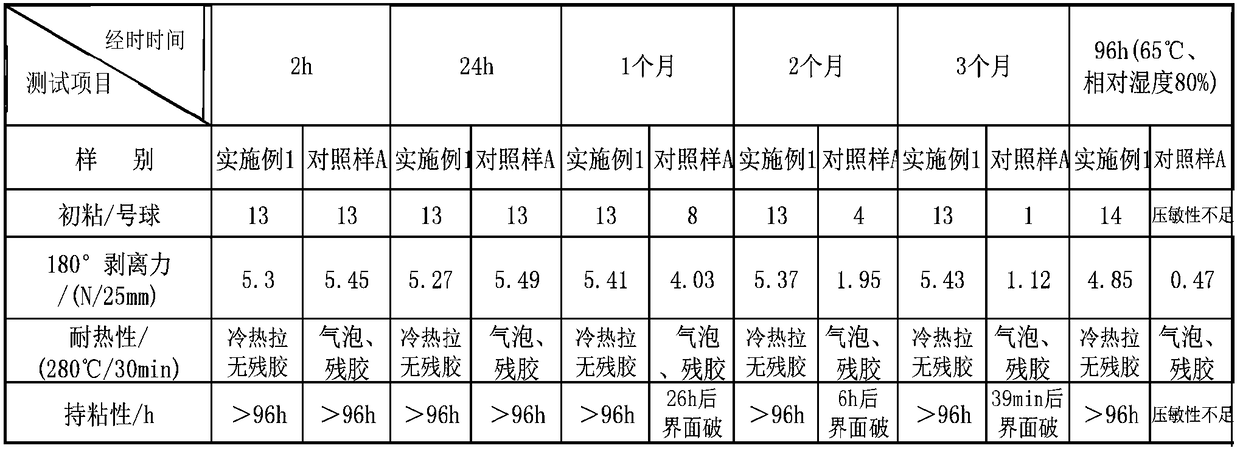A method for extending the stability of silicone pressure-sensitive adhesives
A silicone pressure-sensitive adhesive, stability technology, applied in the direction of adhesives, etc., can solve problems such as viscosity and other performance changes slowly, cannot meet the use requirements, and use performance is unstable, so as to inhibit the occurrence of reverse reactions and achieve better results. Good, good performance
- Summary
- Abstract
- Description
- Claims
- Application Information
AI Technical Summary
Problems solved by technology
Method used
Image
Examples
Embodiment 1
[0033] Step 1) polycondensation reaction
[0034]Put 100Kg of toluene and 200Kg of xylene into the reactor, add 500g of diethylamine, stir evenly, then add 200Kg of hydroxyl-terminated polydimethylsiloxane with a viscosity of about 8000mPa.s and 300Kg of nM / nQ MQ resin with Mn of 0.75 about 5000g / mol, Mw about 18000g / mol and hydroxyl content of about 3% was stirred for 30min under nitrogen protection, then heated to about 135°C and kept under reflux for a stable reaction of about 210min. During the reaction The generated water is continuously discharged through the Dean-Stark trap or U-shaped pipe trap;
[0035] Step 2) Remove water
[0036] The temperature in the reactor was lowered to room temperature, and 1.2 Kg of ethyl orthoacetate was added to the reactor under stirring, and after stirring for 10 minutes, 200 g of acetic acid was added and the stirring was continued for more than 30 minutes;
[0037] Step 3) Removal of Residual Hydroxyl
[0038] Maintain the reaction ...
Embodiment 2
[0052] Step 1) polycondensation reaction
[0053] Put 100Kg of toluene and 200Kg of xylene into the reactor, add 500g of triethylamine, stir evenly, then add 200Kg of hydroxyl-terminated polydimethylsiloxane with a viscosity of about 7000mPa.s and 300Kg of nM / nQ MQ resin with Mn of 0.80 about 5000g / mol, Mw about 18000g / mol and hydroxyl content of about 3% was stirred for 30min under nitrogen protection, then heated to about 135°C and kept under reflux for a stable reaction of about 210min. During the reaction The generated water is continuously discharged through the Dean-Stark trap or U-shaped pipe trap;
[0054] Step 2) Remove water
[0055] Keep the temperature in the reaction kettle at room temperature, add 1.0Kg of water remover ethyl orthoformate to the reaction kettle under stirring, add 200g of formic acid after stirring for 10 minutes and continue stirring for more than 30 minutes;
[0056] Step 3) Removal of Residual Hydroxyl
[0057] Maintain the reaction tempera...
Embodiment 3
[0070] Embodiment 3 (improves the stability of finished product silicone pressure-sensitive adhesive)
[0071] Step 1) Remove water
[0072] Put 1000Kg of domestic finished silicone pressure-sensitive adhesive in the reaction kettle, add 1.5Kg of water remover methyl orthoacetate into the reaction kettle under stirring, add 250g of acetic acid after stirring for 10 minutes and continue stirring for more than 30 minutes ;
[0073] Step 2) remove residual hydroxyl
[0074] Lower the reaction temperature to 50°C under nitrogen protection and stirring, add 7000g of methyl trimethylsilylacetate and stir for 1 hour, keep the adhesive reaction system at about 70°C, and start to deactivate the polycondensation catalyst;
[0075] Step 3) Catalyst deactivation treatment
[0076] Keep the adhesive reaction system at about 70°C under a nitrogen reaction atmosphere, add 10% acetyl chloride toluene solution containing 2.5Kg acetyl chloride to the reaction kettle under stirring, and conti...
PUM
| Property | Measurement | Unit |
|---|---|---|
| viscosity | aaaaa | aaaaa |
| viscosity | aaaaa | aaaaa |
Abstract
Description
Claims
Application Information
 Login to View More
Login to View More - R&D
- Intellectual Property
- Life Sciences
- Materials
- Tech Scout
- Unparalleled Data Quality
- Higher Quality Content
- 60% Fewer Hallucinations
Browse by: Latest US Patents, China's latest patents, Technical Efficacy Thesaurus, Application Domain, Technology Topic, Popular Technical Reports.
© 2025 PatSnap. All rights reserved.Legal|Privacy policy|Modern Slavery Act Transparency Statement|Sitemap|About US| Contact US: help@patsnap.com



